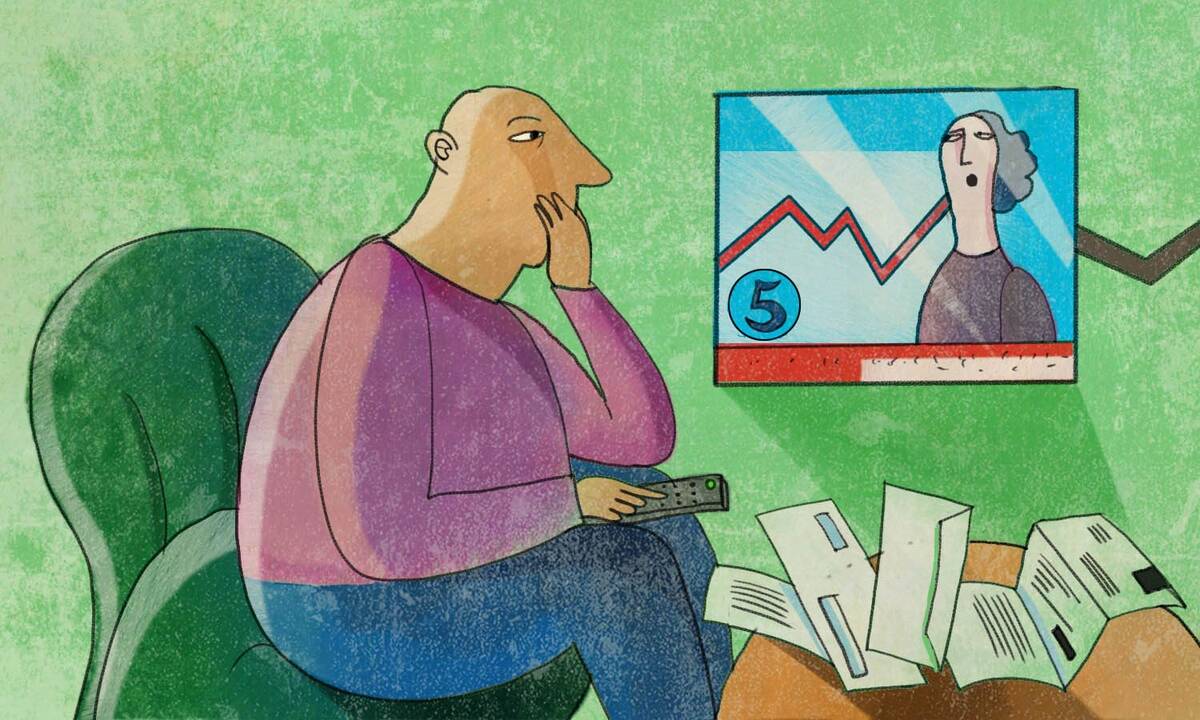Economics Aug 2, 2021
To Better Measure Economic Uncertainty, Look Beyond the Stock Market
Incorporating news sources, surveys, and even Twitter conversations can help give policymakers more nuanced data.

Yevgenia Nayberg
High levels of economic uncertainty usually set off alarm bells among economists. After all, uncertainty about future conditions can immobilize complex economic systems, dampening consumer spending, prompting businesses to freeze investments or pause hiring of workers, and driving up the cost of credit.
So when COVID-19 arrived along with massive economic uncertainty, policymakers scrambled to stabilize the economy. And in order to craft an effective response, many turned to the “gold standard” for measuring economic uncertainty, an index called the VIX.
Yet some economists, including Kellogg’s Scott R. Baker, had thought for years that the VIX was not giving policymakers a full-enough picture. VIX is tied to the stock market; a more complete measure of economic uncertainty, they argued, should draw from a broader suite of metrics, including the opinions of business leaders, journalists, and even regular people.
Several economists, including Baker, had previously developed other metrics for uncertainty. So in the spring of 2020 when Covid hit, Baker and 14 colleagues collaborated on research to compare how various metrics could offer a more granular understanding of uncertainty.
They found that while all measures recorded a steep rise in economic uncertainty, there were some important—and revealing—differences.
The researchers hope their work will encourage policymakers to look beyond the use of stock market–based metrics as a sole measure of economic uncertainty.
“If you, as a policymaker, had been using mostly the VIX as a gauge of uncertainty in the months after the pandemic took hold, you would have seen it drop fairly quickly because Wall Street was calmed by government policy,” Baker says. “But businesses and households were feeling a tremendous amount of uncertainty about the economy, and about what the government was going to do, for a much longer period of time.”
More Perspectives on Uncertainty
Baker and his coauthors represent universities in England, France, Mexico, and the U.S., as well as the Federal Reserve Bank of Atlanta and the Bank of England. In their research collaboration, they trained all of their previously developed uncertainty measures on the same moment: the early months of the COVID-19 pandemic.
Among the new measures is the daily Economic Policy Uncertainty Index, developed by Baker and colleagues in 2016. The index culls through roughly two thousand U.S. newspapers and records daily logs of the number of articles that include the words “economics,” “policy,” and “uncertainty”—or some variant thereof. Values above 100 reflect higher-than-average uncertainty; in March and April 2020, the daily EPU shot to over 500, its highest scores on record.
Another new metric took a similar tack, except it trained its sights on Twitter. This index collected worldwide tweets containing the words “economic” and “uncertainty” (along with their variants) posted between January 1, 2020, and June 1, 2020—roughly 175,000 in total. When the researchers charted the weekly number of tweets containing these terms, they found a nearly identical pattern in uncertainty levels as that displayed by the daily EPU.
“We’ve shown that these metrics can produce very high-quality measures of uncertainty that are consistent with more long-standing and storied metrics.”
— Scott Baker
The third uncertainty measure the researchers tested was an aggregation of results from business expectation surveys, specifically, the U.S.-focused Survey of Business Uncertainty and the U.K.-focused Decision Maker Panel. Both surveys recruit participants from a broad range of public and private companies and ask them to rate the likelihood of various growth scenarios for their businesses over the coming year, as well as how certain they are about those predictions. When the researchers aggregated those responses, they found that uncertainty showed pronounced increases in March and April 2020, and fell back slightly by May 2020.
A fourth uncertainty metric zeroed in on levels of disagreement among professional economic forecasters in the U.S. and the U.K.—specifically, those commenting on likely GDP growth rates one year ahead. The researchers found that disagreement among the forecasters surged to historic levels during the pandemic, with U.S. forecaster disagreement rising eightfold between the first and second quarter of 2020 and U.K. forecaster disagreement jumping twentyfold during that same period.
Finally, the researchers compared these uncertainty measures with the VIX, the Chicago Board Options Exchange’s CBOE Volatility Index. The traditional gold standard in forward-looking economic uncertainty measurement, the VIX calculates its values based on S&P 500 index options prices and registers high levels of financial market uncertainty when the expected change in those prices over the near- or medium-term is high.
The researchers found that the one-month VIX rose from a value of 15 in January 2020 to its highest-ever value of 82.7 on March 16, 2020, and then fell back to below 30 by early May.
Getting More Granular in Looking at Uncertainty
In looking across all of these measures, the researchers were struck by the overwhelming evidence of COVID-19’s far-reaching impact. Indeed, all of the researchers’ metrics, both old and new, charted a quick rise in uncertainty in the wake of the pandemic; most reached all-time peaks.
However, differences across measurements help shed light on how distinct parts of the economy reacted differently during the early months of the pandemic. For example, the researchers find, the duration of peak uncertainty—and the point when it was most pronounced—differed from one measure to the next.
This could be seen in comparing the news-based and Twitter measures to the VIX. Those first two measurements showed continued uncertainty among regular people long after the stock market–based VIX started to level off. This is important for policymakers to know since, of course, the economy is comprised of far more than just financial markets.
“A traditional measure of financial-market volatility like the VIX is very squarely focused on the potential movement of equity prices over the near term,” Baker says, “whereas something like our news-based measure or the Twitter-based measure is more relevant to what households are experiencing more broadly.”
A “Menu of New Measures” Available to Decision Makers
Baker hopes the research helps policymakers take into account a wider range of metrics when making decisions about quelling economic uncertainty. For one thing, he explains, it’s important that the measures be as nimble and rapidly responsive as the economic shocks themselves.
“In the face of really fast-moving shocks where the government is making decisions very rapidly about tremendously huge policy responses—fiscal stimulus, monetary policy, unemployment insurance, regulatory changes, and so on—I think we’ve shown that these metrics can produce very high-quality measures of uncertainty that are consistent with more long-standing and storied metrics,” Baker says.
Policymakers and academics, he says, “can choose the measure that’s most relevant for their purposes rather than reaching for the only one that’s available, which was the situation prior to 10 years ago, when a lot of these alternatives didn’t exist.”
Katie Gilbert is a freelance writer in Philadelphia.
Altig, David, Scott Baker, Jose Maria Barrero, Nick Bloom, Phil Bunn, Scarlet Chen, Steve Davis, Julia Leather, Brent Meyer, Emil Mihaylov, Nick Parker, Thomas Renault, Pawel Smietanka, and Greg Thwaites. 2020. “Economic Uncertainty Before and During the COVID-19 Pandemic.” Journal of Public Economics. 191.



